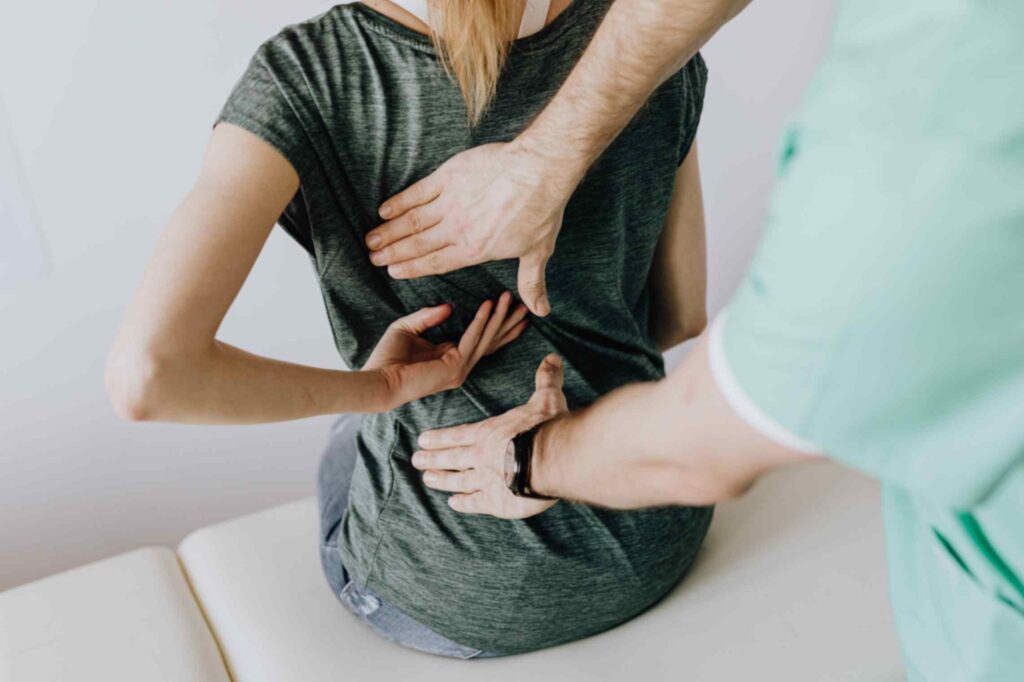
Yoga is a holistic approach to alleviating back pain, combining physical postures, controlled breathing, and mindfulness. It promotes flexibility, strengthens core muscles, and improves posture. It also includes deep breathing and meditation techniques to reduce stress. However, it’s crucial to approach yoga with mindfulness and seek guidance from a healthcare professional. Individual conditions may require modifications, so consult with a healthcare provider.
Table of Contents
Reason of back pain
Back pain is a common and severe condition affecting daily life, causing various forms such as acute discomfort to chronic pain. Causes include poor posture, muscle strain, herniated discs, and underlying medical conditions. Relief can be achieved through ergonomics, exercise, and lifestyle adjustments. Yoga, particularly, has been shown to improve flexibility and core muscle strength. However, each case is unique, and seeking professional guidance is crucial for diagnosis and treatment. Preventive strategies can help manage and mitigate back pain.
Yoga postures for back pain relief
1. Child’s Pose (Balasana):
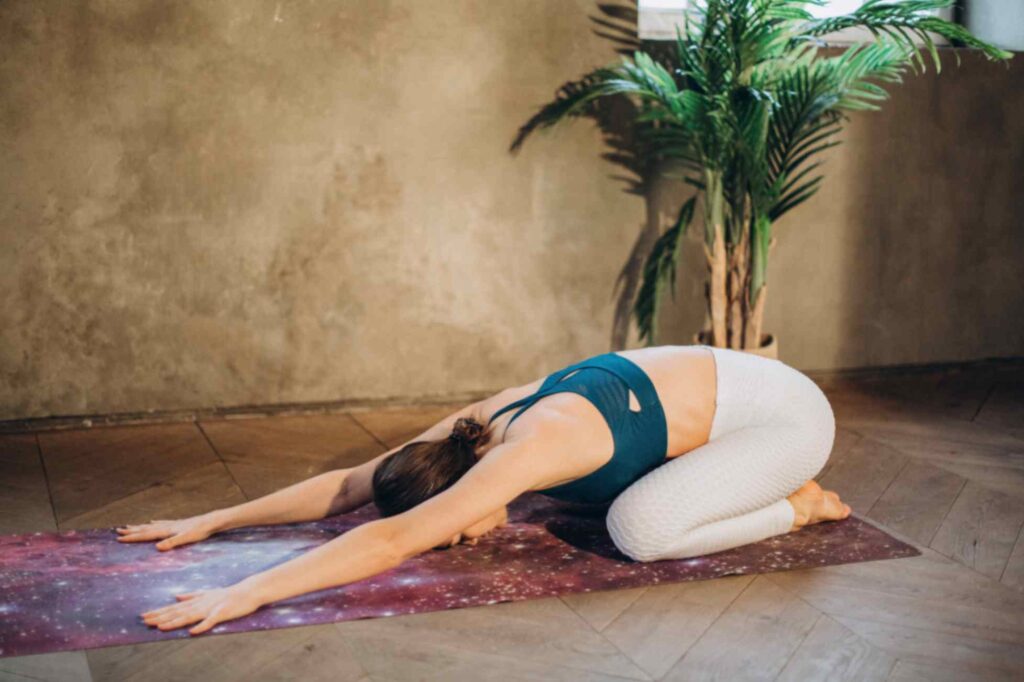
Child’s Pose, known as Balasana in Sanskrit, draws inspiration from the inherent innocence and simplicity of a child at rest. Its roots trace back to the traditional Hatha Yoga practice, where it is often employed as a resting pose between more dynamic sequences.
How to get in Balasana
Child’s Pose, known as Balasana in Sanskrit, draws inspiration from the inherent innocence and simplicity of a child at rest. Its roots trace back to the traditional Hatha Yoga practice, where it is often employed as a resting pose between more dynamic sequences.
Benefits:
- Spinal Relief
- Hip Opener
- Stress Reduction
2. Cat-Cow Stretch (Marjaryasana-Bitilasana)
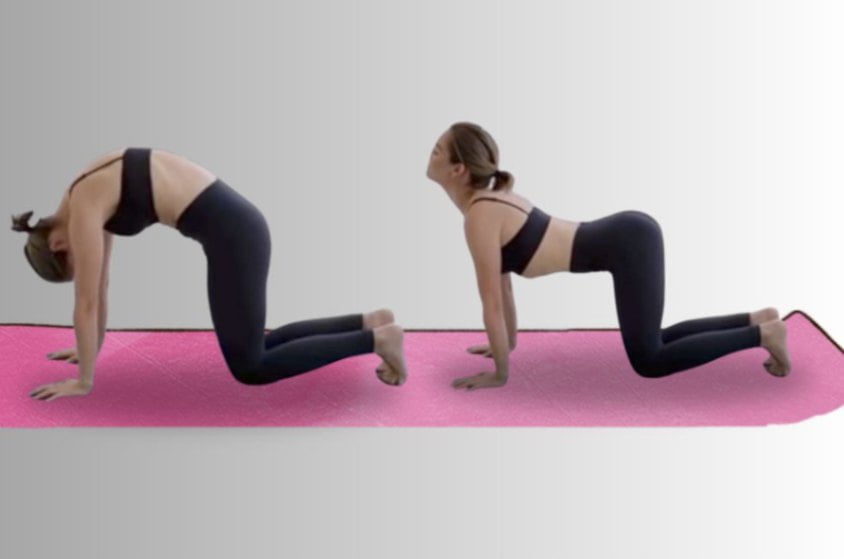
Marjaryasana and Bitilasana, when interwoven, form the Cat-Cow Stretch—a fundamental sequence in Hatha Yoga. Marjaryasana, the cat posture, involves rounding the spine upward, resembling the stretch a cat makes. Bitilasana, the cow posture, arches the back in the opposite direction. Together, they create a fluid movement that not only enhances spinal flexibility but also invites a harmonious connection between breath and motion.
How to get in Cat-Cow Stretch
To ease into Cat-Cow Stretch (Marjaryasana-Bitilasana), start in a tabletop position, aligning wrists under shoulders and knees under hips. Inhale deeply, arch your back into Cat Pose by rounding your spine and tucking your chin. Exhale as you transition to Cow Pose, releasing the arch, sinking your belly, and lifting your head and tailbone. Flow between these poses, syncing your breath with the gentle movements. This dynamic stretch enhances spinal flexibility and encourages a mindful connection between breath and motion. Repeat the sequence, allowing the rhythm of your breath to guide the soothing dance of Cat-Cow Stretch.
Benefits:
- Spinal Flexibility
- Joint Mobilization
- Core Strength
- Improved Posture
- Digestive Massage
- Stress Relief
3.Downward-Facing Dog (Adho Mukha Svanasana)
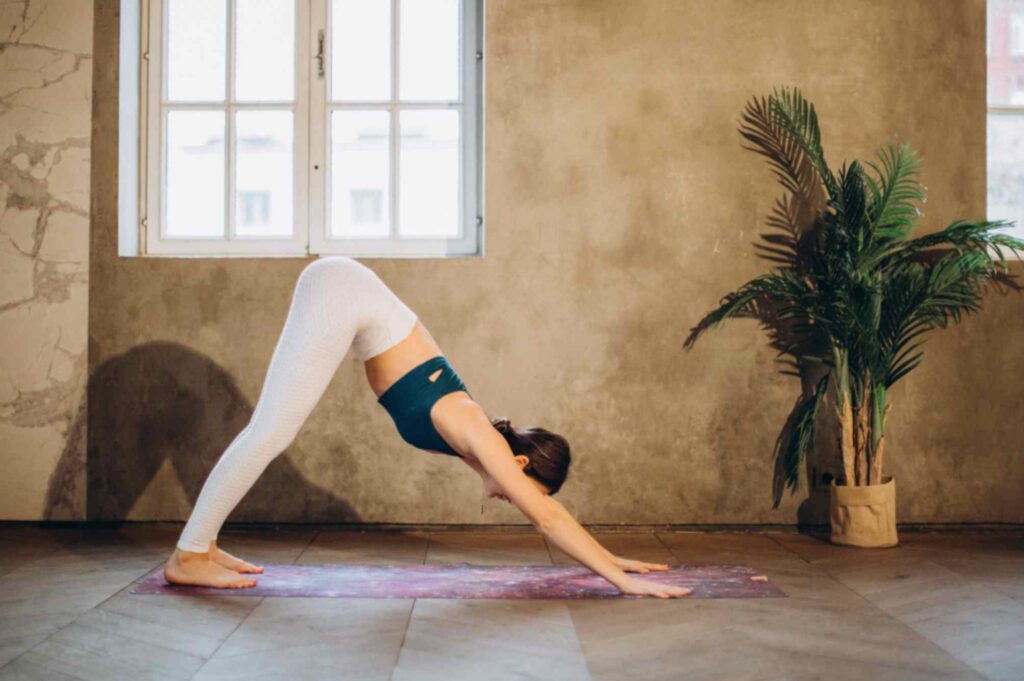
Downward-Facing Dog, or Adho Mukha Svanasana, is a rejuvenating yoga pose that forms a fundamental part of many sequences. To enter this posture, start on your hands and knees, tuck your toes, and lift your hips toward the ceiling, forming an inverted V shape. Keep your hands shoulder-width apart and your feet hip-width apart. The elongated spine and engaged arms create a gentle stretch through the back, hamstrings, and calves. Downward Dog not only strengthens the arms, shoulders, and legs but also provides a revitalizing stretch for the entire body. It’s a versatile pose, serving as a transitional pose, a resting position, or a foundational element in more advanced sequences, making it a cornerstone of any yoga practice.
How to get in Downward-Facing Dog
To perform Downward-Facing Dog (Adho Mukha Svanasana), start on your hands and knees in a tabletop position. Align your wrists under your shoulders and your knees under your hips. Tuck your toes, lift your hips towards the ceiling, and straighten your legs, forming an inverted V shape. Keep your hands shoulder-width apart and your feet hip-width apart. Engage your core, press your palms into the mat, and extend your spine, bringing your chest toward your thighs. Let your head hang freely between your arms, allowing your neck to relax. Feel the stretch in your hamstrings and calves. Downward Dog is a versatile pose, promoting strength, flexibility, and rejuvenation, making it a valuable addition to any yoga routine.
Benefits:
- Enhances Shoulder Flexibility
- Stretches and Strengthens Legs
- Relieves Back Pain
- Energizes the Body
- Strengthens Upper Body
- Builds Core Strength
4.Cobra Pose (Bhujangasana)
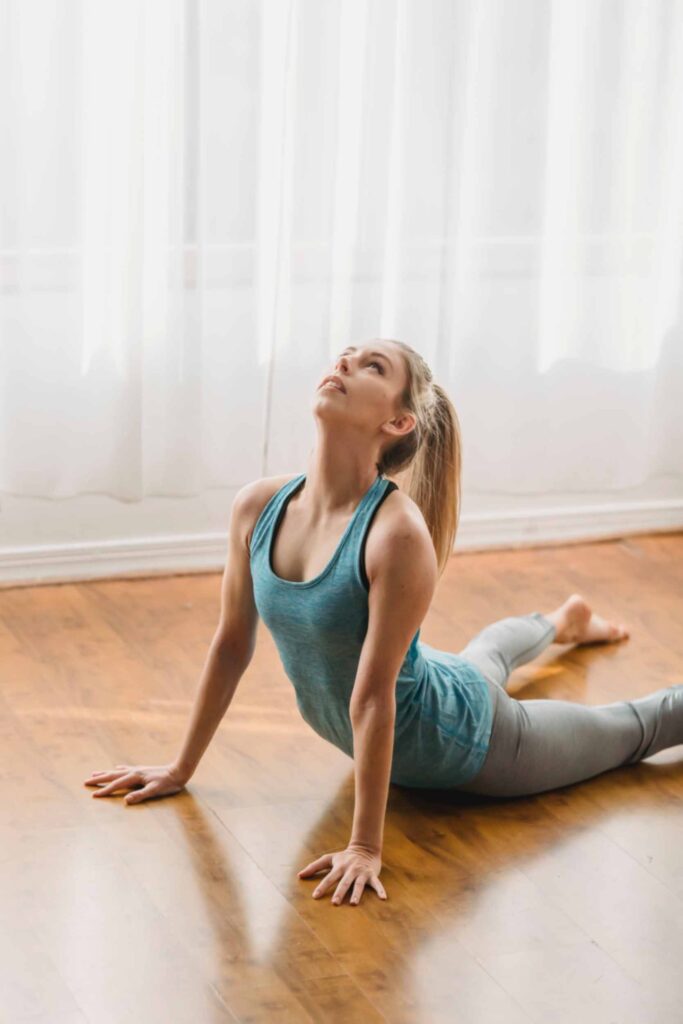
Cobra Pose, or Bhujangasana, is a revitalizing yoga posture that involves lying on your stomach and lifting your chest off the mat while keeping your palms firmly planted. As you elongate your spine and gently arch backward, the pose strengthens the back muscles, opens the chest, and stimulates abdominal organs. Cobra Pose not only enhances spinal flexibility but also serves as a heart opener, promoting improved posture and increased lung capacity. It’s a graceful and accessible pose that encourages a mindful connection between breath and movement, making it an excellent addition to any yoga practice for its rejuvenating effects on the body and mind.
How to get in Cobra Pose
Cobra Pose (Bhujangasana) is a backbend practice that strengthens the back, encourages flexibility, and energizes the body. It involves lying on your stomach with legs extended and feet flat on the mat. Place palms on the mat under your shoulders, bend elbows, and inhale deeply. Lift your chest off the ground, engage your back muscles, and maintain contact with the mat. Hold the pose for a few breaths, then exhale.
Benefits
- Spinal Flexibility
- Strengthens Back Muscles
- Opens the Chest
- Relieves Back Pain
- Stimulates Kidney Function
- Eases Menstrual Discomfort
5.Upward-Facing Dog (Urdhva Mukha Svanasana)
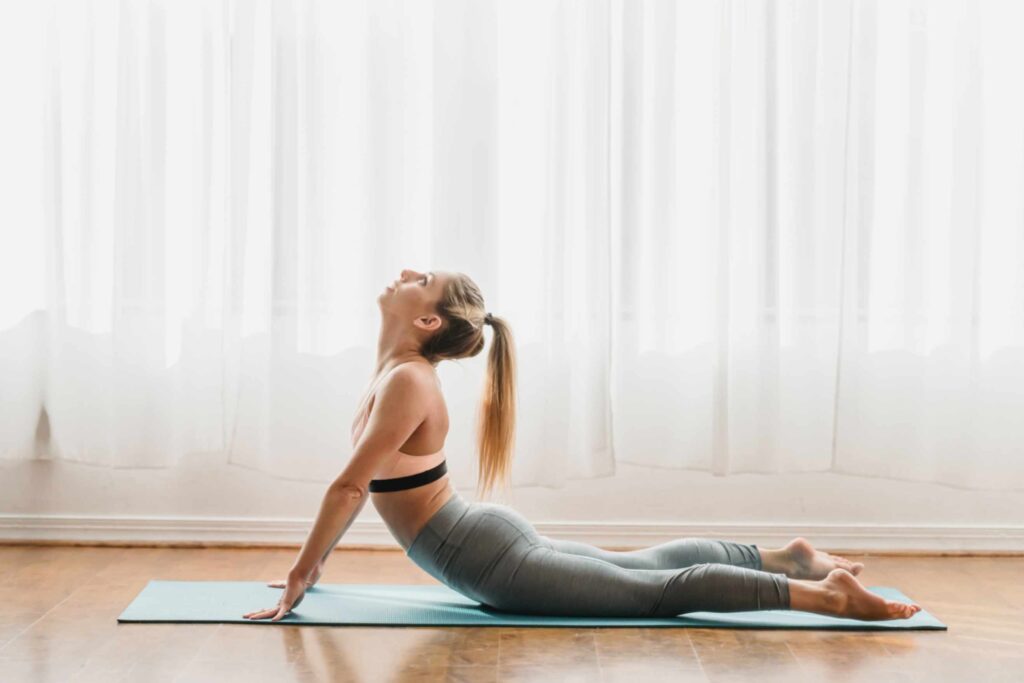
Upward-Facing Dog, or Urdhva Mukha Svanasana, is a invigorating yoga pose that involves lying on your stomach, placing your palms beside your ribcage, and lifting your chest and thighs off the mat. In this heart-opening posture, your arms straighten as you roll your shoulders back, creating a gentle backbend. Upward Dog not only strengthens the arms, wrists, and back muscles but also stretches the chest and abdomen. This pose stimulates the abdominal organs and opens up the lungs, promoting better respiratory function. It’s a dynamic and uplifting pose that encourages a mindful blend of strength and flexibility, making it a beneficial addition to any yoga practice for its rejuvenating effects on the body and overall sense of energy.
How to get in Upward-Facing Dog
Cobra Pose (Bhujangasana) is a backbend practice that strengthens the back, encourages flexibility, and energizes the body. It involves lying on your stomach with legs extended and feet flat on the mat. Place palms on the mat under your shoulders, bend elbows, and inhale deeply. Lift your chest off the ground, engage your back muscles, and maintain contact with the mat. Hold the pose for a few breaths, then exhale.
Benefits
- Strengthens Upper Body
- Opens the Chest
- Stretches the Abdomen
- Strengthens the Lower Back
- Improves Circulation
- Stimulates Nervous System
6.Bridge Pose (Setu Bandhasana)
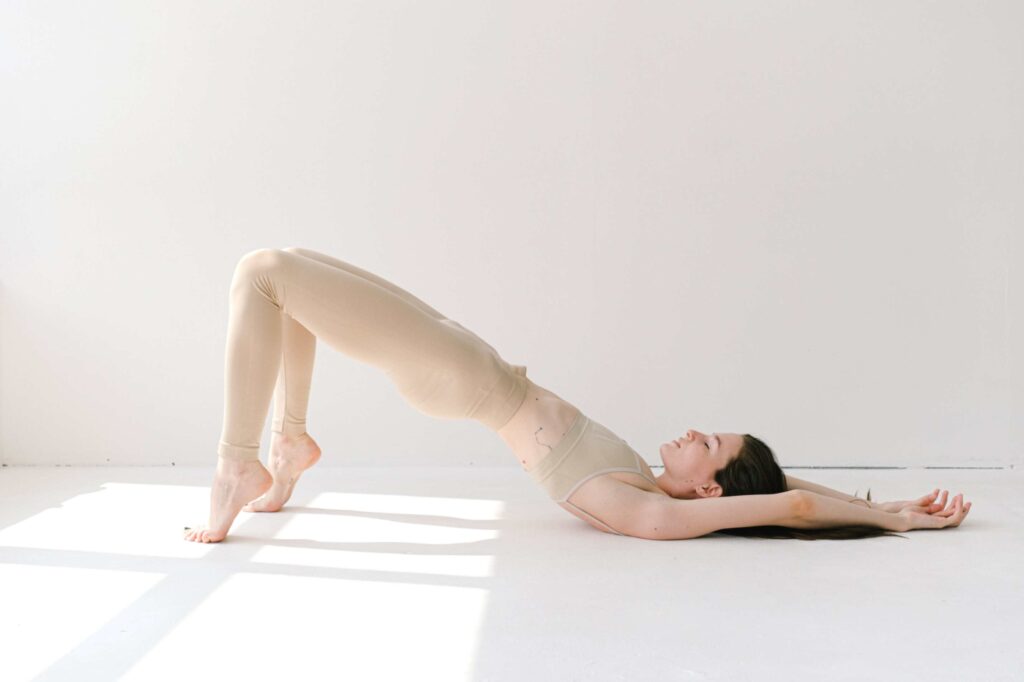
Bridge Pose, or Setu Bandhasana, is a rejuvenating yoga posture that involves lying on your back, bending your knees, and lifting your hips toward the sky. Placing your palms flat on the mat, you gently roll your shoulders beneath you, creating a bridge-like shape with your body. This heart-opening pose not only strengthens the legs, glutes, and lower back but also stretches the chest and neck. Bridge Pose is a versatile asana that promotes spinal flexibility, stimulates the abdominal organs, and provides a gentle release for the spine. It’s an accessible yet impactful pose that encourages balance, strength, and a sense of openness in both body and mind.
How to get in Bridge Pose
Bridge Pose is a backbend that promotes flexibility and strength. It involves lying on your back with knees bent, feet hip-width apart, and arms facing down. Engage your glutes, lift your hips, roll your shoulders, and maintain parallel thighs. Hold for a few breaths, then release and lower your spine.
Benefits
- Strengthens the Legs and Glutes
- Opens the Chest and Lungs
- Alleviates Back Pain
- Enhances Hip Flexibility
- Prepares for Deeper Backbends
- Improves Spinal Flexibility
7.Puppy Pose (Uttana Shishosana)
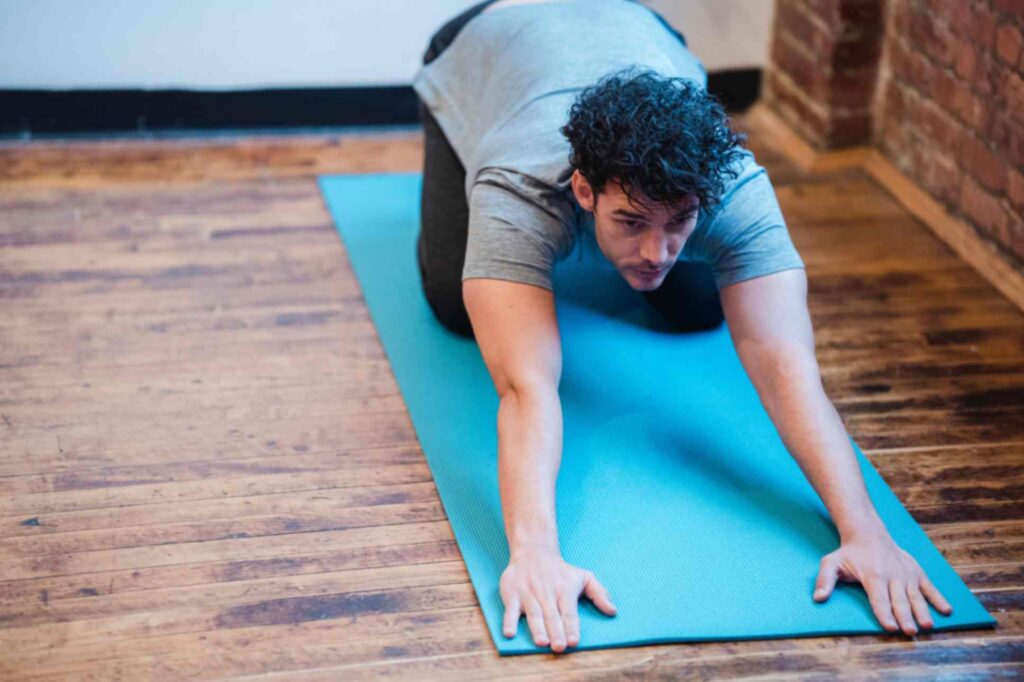
Puppy Pose, or Uttana Shishosana, is a delightful yoga posture that combines elements of a gentle stretch and a heart-opening pose. Starting in a tabletop position, lower your chest towards the mat while keeping your hips aligned over your knees. Extend your arms forward, lowering your forehead to the ground. The pose offers a soothing stretch for the spine, shoulders, and arms while maintaining a connection to the earth. Puppy Pose is a perfect blend of surrender and elongation, promoting flexibility in the upper body and a sense of calm relaxation. It serves as an accessible and rejuvenating pose for practitioners of various levels, providing a moment of serenity in the midst of dynamic yoga sequences.
How to get in Puppy Pose
To ease into Puppy Pose (Uttana Shishosana), start in a tabletop position with your wrists under your shoulders and knees under your hips. Inhale deeply, then exhale as you walk your hands forward, lowering your chest toward the mat while keeping your hips above your knees. Extend your arms fully, allowing your forehead to rest on the ground. Keep a gentle arch in your lower back and lengthen through your spine. Feel a delightful stretch in your shoulders, upper back, and arms. Puppy Pose is a simple yet rejuvenating posture that encourages a sense of surrender and relaxation, making it an accessible addition to any yoga routine.
Benefits
- Shoulder and Upper Back Stretch
- Spinal Extension
- Opens the Chest
- Relieves Tension in the Neck
- Encourages Relaxation
- Improves Shoulder Flexibility
8.Triangle Pose (Trikonasana)
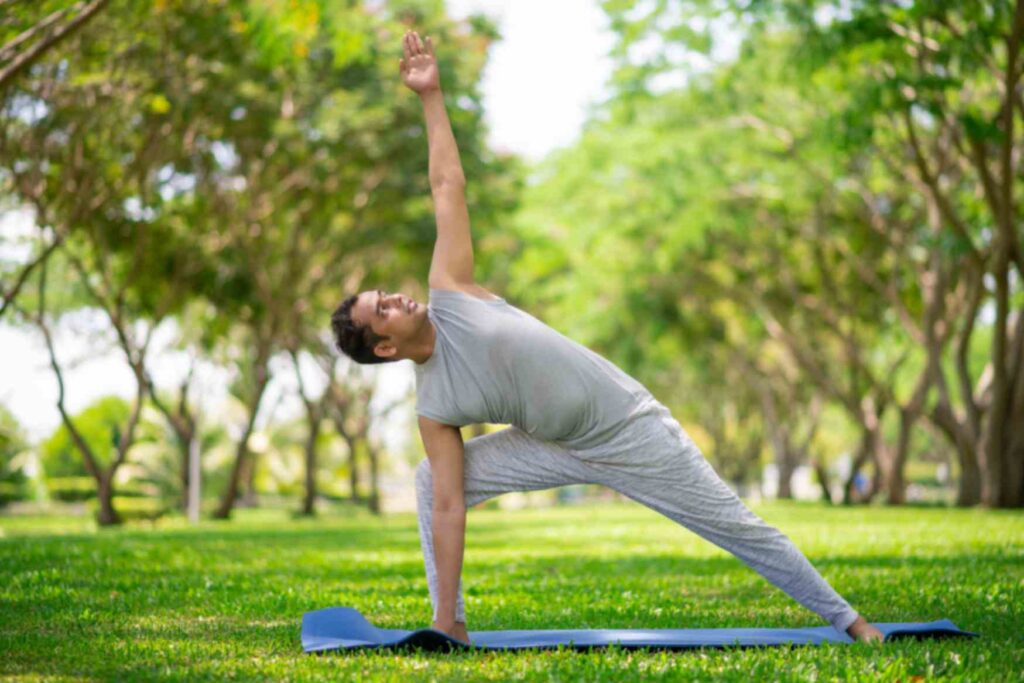
Triangle Pose, or Trikonasana, is a classic yoga posture that embodies strength and expansion. To enter the pose, stand with your feet wide apart, extend your arms parallel to the ground, and reach toward one foot while keeping the other foot firmly rooted. The body forms a triangle shape, and the gaze can extend to the raised hand. This asana not only stretches and strengthens the legs, hips, and spine but also engages the core. Trikonasana encourages balance, stimulates digestion, and promotes a sense of openness. Its dynamic combination of grounding and extension makes Triangle Pose a fundamental and invigorating posture in yoga practice.
How to get in Triangle Pose
Triangle Pose (Trikonasana) is a yoga pose that involves standing with feet wide apart, turning your right foot outward by 90 degrees, and slightly pivoting your left foot inward. Extend your arms parallel to the ground, aligning them with your shoulders. Inhale, reach your right hand towards your ankle or shin, while lifting your left hand towards the sky. Maintain an elongated torso and avoid leaning forward. This pose promotes strength and flexibility, and can be repeated on the other side for a balanced practice.
Benefits:
- Stretches and Strengthens
- Opens the Hips
- Improves Balance and Focus
- Enhances Lung Capacity
- Lengthens the Spine
- Alleviates Stress
9.Seated Forward Bend (Paschimottanasana)
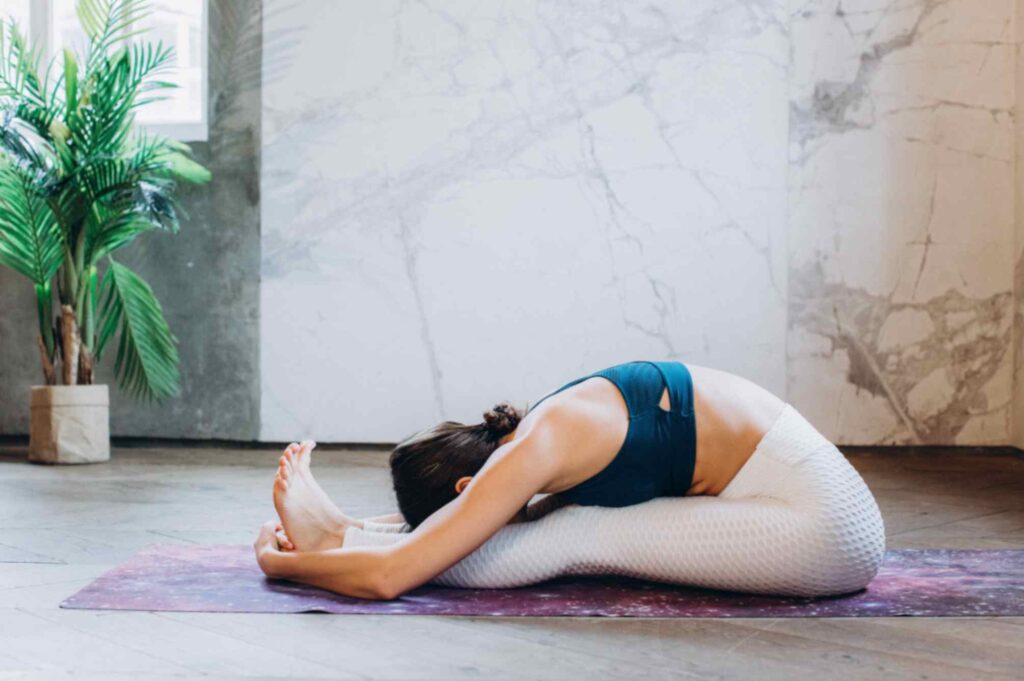
Seated Forward Bend, or Paschimottanasana, is a grounding yoga pose that invites a gentle surrender to the present moment. Seated with legs extended, hinge at the hips, and reach forward toward your toes. The spine gently rounds, and the chest moves toward the thighs. Paschimottanasana provides a deep stretch along the entire back of the body, from the heels to the crown of the head. This asana cultivates flexibility in the hamstrings, stimulates the abdominal organs, and promotes a sense of calm. It’s a posture that encourages introspection and mindfulness, fostering a connection between breath, body, and the quietude of the mind.
How to get in Seated Forward Bend
Paschimottanasana is a pose that involves sitting on the floor with legs extended in front of you, ensuring a straight spine and toes pointing towards the ceiling. Inhale deeply to lengthen your spine, then hinge at the hips and reach forward with your hands. Hold onto your shins, ankles, or feet, and engage your quadriceps to deepen the stretch. Relax your neck and gaze towards your toes. Stay in the pose for a few breaths, feeling a gentle stretch in your hamstrings and lengthening your spine.
Benefits:
- Hamstring Stretch
- Spinal Flexibility
- Stimulates Abdominal Organs
- Calms the Nervous System
- Reduces Fatigue
- Improves Posture
10.Cow Face Pose (Gomukhasana)
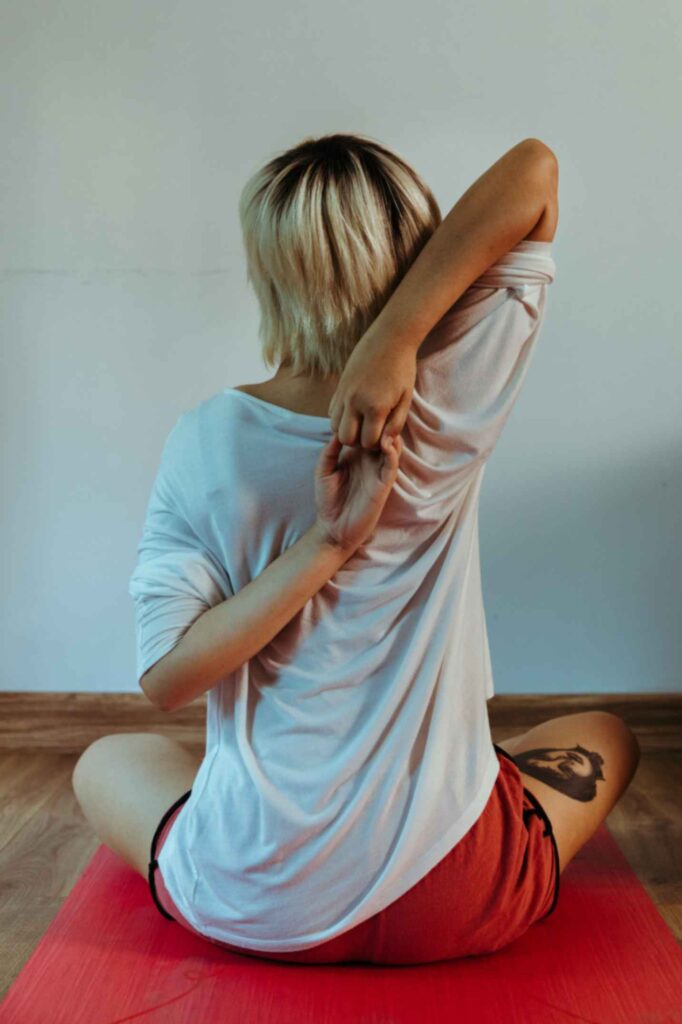
Cow Face Pose, or Gomukhasana, is a yoga posture that brings a delightful stretch to the shoulders, chest, and hips. In this seated pose, one arm extends overhead, reaching down the back, while the other arm extends behind the back, reaching up. The goal is to eventually clasp the fingers of both hands behind the back, creating a cow face-like shape. Gomukhasana not only enhances shoulder flexibility and opens the chest but also stretches the hips and thighs. This asymmetrical pose encourages balance, increases the range of motion in the shoulders, and promotes a sense of relaxation. Cow Face Pose is a unique and invigorating posture that harmoniously combines strength and flexibility in the upper body.
How to get in to Cow Face Pose
Cow Face Pose (Gomukhasana) is a pose that involves sitting on a mat with legs extended in front of you. Bend your knees and bring your left foot under your right knee, placing it outside your right hip. Cross your right leg over your left, stacking your knees directly over the left one. Align your knees, inhale, and extend your right arm overhead. Bend your elbow, bringing your hand down your back, and reach your left arm behind your back, aiming to clasp your fingers. Keep your spine straight, chest open, and gaze forward. Hold the pose for several breaths before releasing and switching sides. This pose promotes flexibility and balance.
Benefits:
- Stimulates Kidneys
- Alleviates Sciatic Pain
- Stimulates Digestive Organs
- Chest Opener
- Shoulder Stretch
- Balances the Nervous System
“Thank you for joining us on this journey to alleviate back pain through the transformative practice of yoga. Your commitment to your well-being is truly commendable. Remember, these poses are not just about physical relief but also about fostering a deeper connection with your body and mind. As you embark on your yoga journey, be patient and kind to yourself. Celebrate the small victories, embrace the process, and continue to prioritize self-care. We hope these poses bring you lasting comfort and a renewed sense of vitality. May your path to wellness be filled with joy, resilience, and the radiance that comes from nurturing your own well-being. Namaste.”
You might also be interested in NEUROIMAGING:14 BRAIN IMAGING METHODS

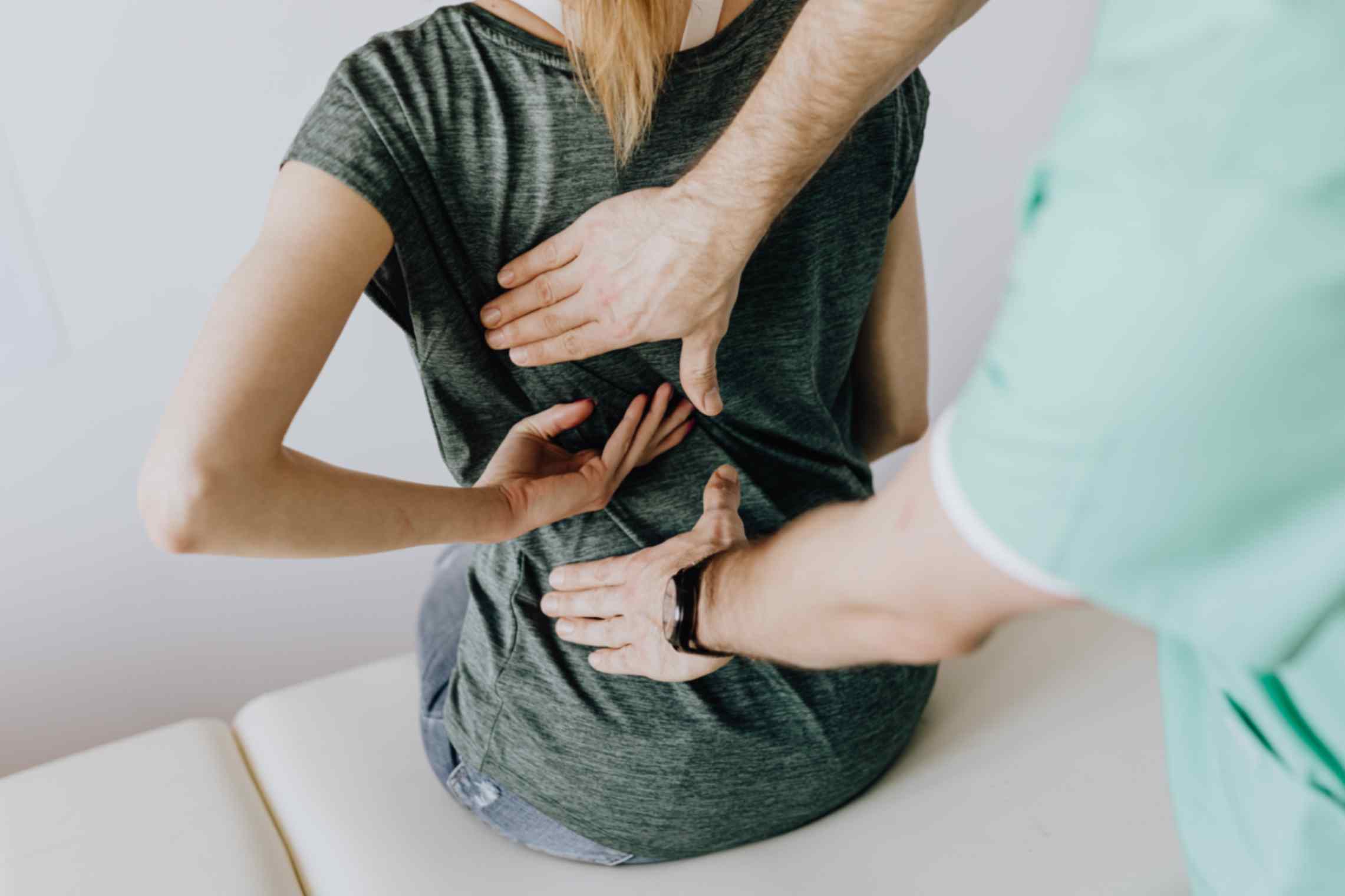
1 thought on “Revitalize Your Spine: 10 Empowering Yoga Poses for Blissful Back Relief”